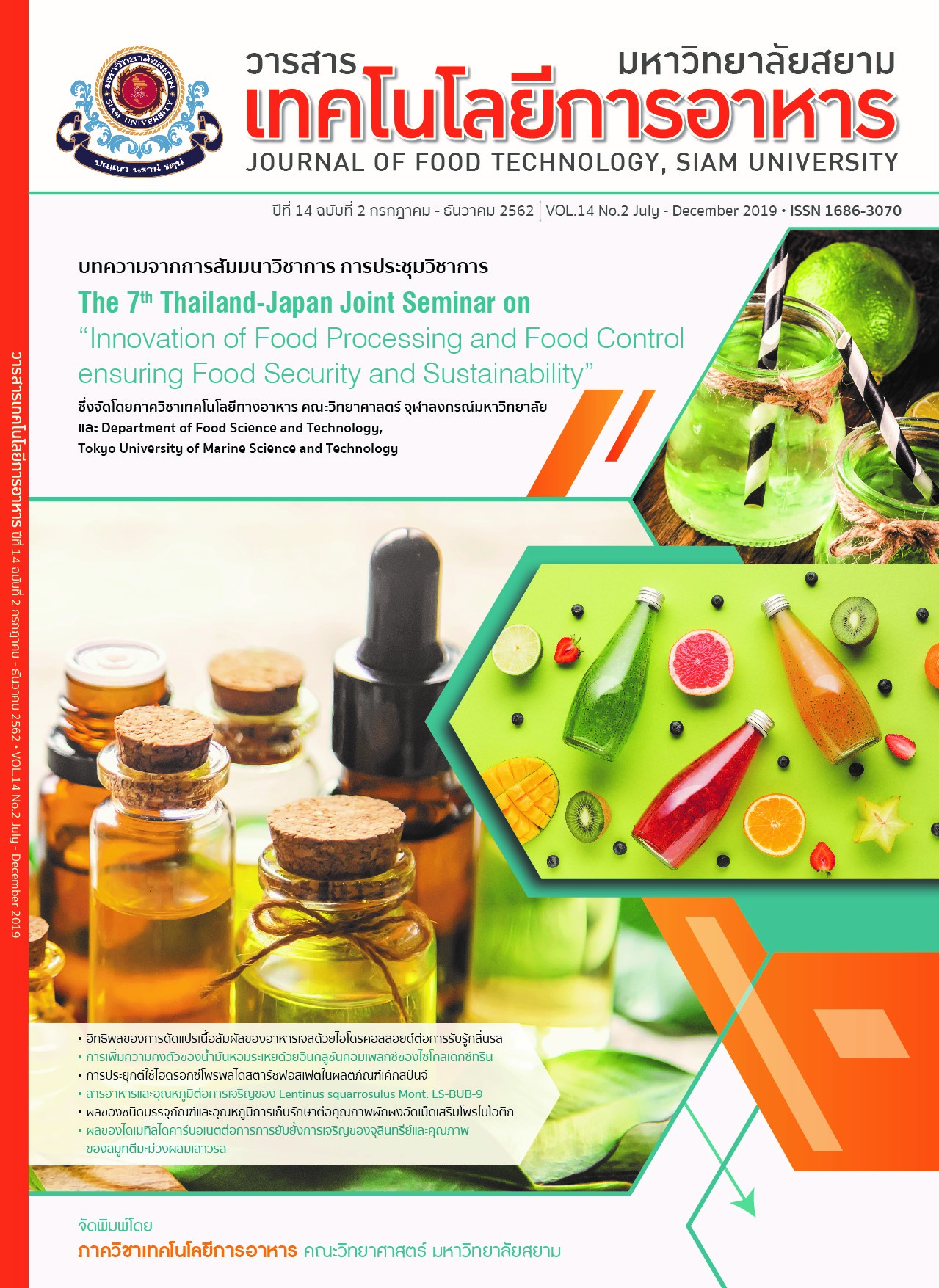Effect of Dimethyl Dicarbonate on Microbial Degradation and Quality of Mixed Mango and Passion Fruit Smoothie
Main Article Content
Abstract
The aims of this research were to study the effect of dimethyl dicarbonate or DMDC (0-250 ppm) on microbial degradation (total plate count, yeast and mold, Escherichia coli ATCC 25922 and Staphylococcus aureus ATCC 25923) and chemical and physical properties including pH, total acid (%citric acid), total soluble solid (ºBrix) and color (L*, a* and b*) of mixed mango and passion fruit smoothie. Graph plotting between microbial population and DMDC concentration according to the zero-order and first-order kinetic model were performed. Results showed that the microbial degradation by DMDC of all tested microorganisms followed first-order kinetic model because correlation coefficient (R2) from first-order kinetic model was higher than those of zero-order kinetic model. R2 from first-order kinetic model of total plate count, yeast and mold, E. coli ATCC 25922 and S. aureus ATCC 25923 were 0.9496, 0.9333, 0.9582 and 0.9389, respectively. Rate constants ( ), a constant of microbial degradation of first-order kinetic model, were between 0.0201 – 0.4040. Moreover, S. aureus ATCC 25923 was the most sensitive microorganisms to DMDC since it had the highest value from first-order kinetic model (0.4040). In addition, DMDC at 250 ppm inhibited E. coli and S. aureus approximately 4 log-reduction. When considering chemical and physical properties, it was found that DMDC did not significantly affect pH, total acidity, total soluble solids and color values (p>0.05).
Article Details
Copyrights of all articles in the Journal of Food Technology available in print or online are owned by Siam University and protected by law.
References
[2] Food intelligence Center Thailand. (2015). Ready-to-drink market in Thailand. [Online] Available from https://fic.nfi.or.th/ MarketOverviewDomesticDetail.php?id=81. [Accessed May, 27, 2019]. (in Thai).
[3] Müller, L., Gnoyke, S., Popken, A.M., and Böhm, V. (2010). Antioxidant capacity and related parameters of different fruit formulations. LWT – Food Science and Technology. 43(6): 992-999.
[4] Office of the Permanent Secretary Ministry of Commerce. (2018). Top 15 export markets in Thailand. [Online] Available from https://www.ops3.moc.go.th/infor/ menucomth/stru1_export/export_topn_re/ report.asp. [Accessed May, 27, 2019]. (in Thai).
[5] Ribeiro, S.M.R. and Schieber, A. (2010). Bioactive Compounds in Mango (Mangifera indica L.). Bioactive Foods in Promoting Health: Fruits and Vegetables. 507-523.
[6] Malaterre, A.S., Stanislas, G., Douraguia, E. and Gonthier, M.P. (2016). Evaluation of nutritional and antioxidant properties of the tropical fruits banana, litchi, mango, papaya, passion fruit and pineapple cultivated in Réunion French Island. Food Chemistry. 212: 225-233.
[7] Food and Drug Administration. (2019). Food Act 1979 with Ministerial Regulations and Ministry of Public Health announcement (Revised version 2019). [online]. source: https://www.fda.moph.go.th/sites/food/ law1/food_law.pdf. [Accessed May, 27, 2019]. (in Thai).
[8] Chitov, T. (2015). Food Microbiology. 1st Edition. Chulalongkorn University Printing House, Bangkok. (in Thai).
[9] Dziedzinska, R., Moravkova, M., Hrdy, J., Slana, I., Vlkova, H., Kunstovna, H. and Vasickova, P. (2018). Occurrence of selected viral, bacterial and protozoan pathogens in fresh juices and smoothies in Prague, Czech Republic. Food Control. 93: 310-314.
[10] Hurtado, A., Guàrdia, M.D., Picouet, P., Jofré, A., Ros, J.M. and Bañón, S. (2016). Stabilization of red fruit‐based smoothies by high‐pressure processing. Part A. Effects on microbial growth, enzyme activity, antioxidant capacity and physical stability. Journal of the Science of Food and Agriculture. 97(2): 770-776.
[11] Threlfall, R.T. and Morris, J.R. (2002). Using Dimethyl dicarbonate to Minimize Sulfur Dioxide for Prevention of Fermentation from Excessive Yeast Contamination in Juice and Semi-Sweet Wine. Food Microbiology and Safety. 67(7): 2758-2762.
[12] Cheng, R.M., Churey, J.J. and Worobo, R.W. (2018). Inactivation of Salmonella enterica and spoilage microorganisms in orange juice treated with dimethyl dicarbonate (DMDC). International Journal of Food Microbiology. 285: 152-157.
[13] USFDA. (2018). CFR - Code of Federal Regulations Title 21. [Online] Available from https://www. accessdata.fda.gov/ scripts/cdrh/cfdocs/cfcfr/CFRSearch.cfm?fr=172.133. [27 May 2019].
[14] Bacteriological Analytical Manual. (2001). U.S. Food and Drug Administration. Center for Food Safety and Applied Nutrition, USA.
[15] AOAC. (1995). Official Method of Analysis of AOAC International. 15th edition. Association of Official Analytical Chemists, Washington D.C.
[16] Assatarakul, K. (2016). Degradation kinetic models and inactivation of pathogenic microorganisms by dimethyl dicarbonate in fresh mandarin juice. Journal of Food Safety. 37(2): e12319
[17] Gouma, M., Gayán, E., Raso, J., Condón, S. and Álvarez, I. (2015). Influence of dimethyl dicarbonate on the resistance of Escherichia coli to a combined UV-Heat treatment in apple juice. Frontiers in Microbiology. 6: 501.
[18] NCBI. (2019). COMPOUND SUMMARY; Dimethyl dicarbonate. [Online] Available from https://pubchem. ncbi.nlm.nih.gov/ compound/ dimethyl_dicarbonate. [Accessed May, 27, 2019].
[19] Government Gazette (2019). Ministry of Public Health announcement No.389, 2018, Food additive (Issue 5). [Online] Available from https://www.ratchakitcha. soc.go.th/DATA/PDF/2561/E/178/1.PDF. [Accessed May, 27, 2019]. (in Thai).
[20] Van Boekel, M.A.J.S. (2008). Kinetic modeling of reactions in foods. 1st Edition. UK: CRC Press, London.
[21] William, R.C., Sumner, S.S. and Golden, D.A. (2005). Inactivation of Escherichia coli O157:H7 and Salmonella in apple cider and orange juice treated with combinations of ozone, dimethyl dicarbonate, and hydrogen peroxide. Journal of Food Science. 70(4): 197-201.
[22] Whitney, B.M., William, R.C., Eifert, J. and Marcy, J. (2008). High pressures in combination with antimicrobials to reduce Escherichia coli O157:H7 and Salmonella Agona in apple juice and orange juice. Journal of Food Protection. 71(4): 820-824.
[23] Guo, H., Yu, Y., Xiao, G., Xu, Y. and Wu, J. (2015). Changes in quality attributes during storage of litchi juice treated with dimethyl dicarbonate (DMDC) and nisin. Journal of Food Research. 4(4): 81-91.
[24] Chen, Y., Wang, H., Xu, Y., Wu, J. and Xiao, G. (2013). Effect of treatment with dimethyl dicarbonate on microorganisms and quality of Chinese cabbage. Postharvest Biology and Technology. 76: 139-144.
[25] USFDA. (2017). Guidance for industry: juice HACCP and the FDA Food Safety Modernization Act. [Online] Available from https://www.fda.gov/regulatory-information/search-fda-guidance-documents/guidance-industry-juice-haccp-and-fda-food-safety-modernization-act. [Accessed May, 27, 2019].


